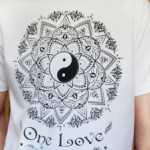Yamaha Pianica 36, P-36
Tagged: P-36, Pianica 36
- This topic has 10 replies, 3 voices, and was last updated 3 years, 8 months ago by
 Alan Brinton.
Alan Brinton.
-
AuthorPosts
-
August 7, 2015 at 8:46 pm #5776
 Alan BrintonParticipant
Alan BrintonParticipantYamaha stopped selling 36 key Pianicas in 1979. I have been trying to acquire one for some time without success. Occasionally, one is listed as an auction item, though almost always in Mexico, South America (Peru, Brazil, Argentina) or in Spain, and not appearing to be in very good condition. All the photos show a black Yamaha Pianica that has features of a late 1960s to early 1970s model, including metal tray. Just recently, though, I have scored two from Japan, one of which arrived today, while the other is in transit. Why have I purchased two? Well, although they look very similar, the first one, pictured here
is a Yamaha Pianica 36, while the second is a Yamaha Pianica P-36.
Use of the “P” designation seems to have begun in 1970, and its absence is usually an indicator that the instrument is a 1960s model.
The P-36 also looked to be in better condition, also suggested by the fact that it includes a brochure and cleaning cloth, which is more common with melodicas that have been used less and/or preserved more carefully.
I will give a full report when both of these are in hand and I’ve had enough time to take them apart and make comparisons.
The Pianica 36 arrived somewhat dirty and scuffed up. One key has what I guess can be described as a hairline fracture, but one that doesn’t seem to have any functional significance. This Pianica is relatively air tight, and all notes play.
August 22, 2015 at 9:19 pm #5832 Alan BrintonParticipant
Alan BrintonParticipantOkay, the P-36 has arrived.
The earlier Pianica 36 and this, the Pianica P-36, are identical. I believe it can be said with confidence now that the regular 36 key Yamaha Pianica was introduced in the mid to late 1960s and continued virtually unchanged until production ceased in 1979. There seems to have also been a P-36A variant, which also ceased production in 1979. But the parts lists for the P-36 and P-36A are nearly identical, including the same reed plates. In 1979, a P-37C model was introduced and was replaced in 1988 by the current P-37D. The parts lists for those two models are nearly identical to each other. So it was in 1979 that a the very new P-37C/D replaced the original Pianica/P-36. The Pianica 36 had four reed plates, while its successor P-37C/D has three. The P-37 has a smoother more refined, more clarinet-like sound than that of the P-36, which is brighter and has a slight “ringiness” to it, more in the direction of the metal tray Suzuki M-37C. I find the sound of the P-36 to be very agreeable. Which is better would, I guess, be a matter of personal preference. One of the biggest changes from the P-36 to the P-37, is abandonment of the metal tray.
More photos now:
August 22, 2015 at 9:33 pm #5833 Alan BrintonParticipant
Alan BrintonParticipantP-36


After the two main screws on either end are removed, the inner melodica slides out easily.

What appeared to be a hairline fracture on the B below high C was actually just a part of a scratch that could be mostly rubbed away.





Notice that key action is adjustable via the screwheads at the top of the springs.August 22, 2015 at 10:12 pm #5834 Alan BrintonParticipant
Alan BrintonParticipant

Very solid construction throughout. The more closely I examined these two Pianicas, the more I was convinced that the Pianica 36 (P-36) was Yamaha’s answer to the Hohner Professional 36. It has the look and feel, the solidity, the attractiveness of a professional musical instrument.The shaft venting mechanism with the button at the mouthpiece end is, in my opinion, as executed on this model, the most effective “spit valve” to be found on any melodica (with the possible exception of the kind of screw caps found on the Suzuki Pro-V37 and on vintage 36 key Hohners), though some might not like the location of the button.


Here, now, is the only undesirable feature of the Pianica 36/P-36, and it’s a significant problem.

As can be seen, the reed chamber cover is sealed and cannot be removed without breaking the seal, which I am unwilling to do at this time. I have been playing the P-36 and its tuning is acceptable to me; but if it needed tuning, the seal would be a problem.


Prior to breaking the seal, the metal strip with the 7 screws has to be removed.
This Pianica, which weighs 943 grams (as compared with the P-32D’s 790 grams) does not have a hand strap. This instrument is quite a handful.I have illustrated in so much detail because I think this is Yamaha’s premiere vintage Pianica. I think it comes the closest to occupying a place among vintage Japanese keyboard harmonicas comparable to the place the Hohner Professional 36 (and to some extent its successor Piano 36) occupies among vintage Hohner Melodicas. The Suzuki 36 key Melodions are very good, but not in the same class with the P-36.
August 23, 2015 at 1:25 am #5835 AndreParticipant
AndreParticipantHi Alan
Nice good looking pianicas 🙂October 28, 2015 at 4:18 pm #6180 DarenKeymaster
DarenKeymasterGreat photos here Alan. Especially the valve mechanism. What a strange foresight to not be able to get to the reeds. I presume they’re not single reeds in there like the Pro36?
October 28, 2015 at 8:00 pm #6181 Alan BrintonParticipant
Alan BrintonParticipantI’d be shocked if it had single reeds, since I have not found them on any Japanese keyboard harmonica. The likeliest candidates would be those whose design seems derivative from the Clavietta, for example the Suzuki S-25 and the Tokai Gakki PC-1 (which has a laminated wooden sound board). But neither of these or any of the many other Yamahas or Suzukis I’ve examined has individually mounted reeds. The very first Suzuki Super 34 is another possibility, but I don’t have one of those.
Possibly there’s a way I haven’t figured out to get at the reeds of the Pianica 36, or I might just decide to break the seal on the older one and take my chances. I’m not convinced that single reeds are a difference maker, though they sure are cool!
I acquired a Tokai Gakki PC-1 recently and just took it apart to check the reeds. I’m takingphotos that I’ll post soon. The reed plates are mounted directly on the laminated wood soundboard.
October 29, 2015 at 6:35 pm #6183 DarenKeymaster
DarenKeymasterOk, looking forward to seeing these pics. I wonder whether there’s any sign of warping on the laminate wood soundboard…
October 29, 2015 at 10:45 pm #6185 Alan BrintonParticipant
Alan BrintonParticipantNo warping that I can see. It’s very solid and heavily lacquered.
October 27, 2016 at 8:25 pm #7770 Alan BrintonParticipant
Alan BrintonParticipantPIANICA 36 UPDATE:
Today, working on the older Pianica 36 (rather than the later P-36) I figured out how to further disassemble to get access to the reeds, which after all did not require breaking a seal.
I don’t know why I didn’t notice the clips before. Once they are removed, the reed chamber cover can be peeled off without damaging the gasket.
I was hoping, though not expecting, to find individual reeds as in the Clavietta and Hohner Professional. There are four reed plates, two short ones at the bottom end and two longer ones on the top. There is significant discoloration, but the reeds are in good condition and show little sign of post-factory tuning.
I checked the tuning and was surprised to find that, measuring at A=442, the tuning was actually not bad — this is a later 1960s model that does not appear to have been tuned by a previous owner — so we’re talking about tuning done 45+ years ago. Key action and tone were uneven, with a few edgier sounding notes. By gapping one of those notes and adjusting key action with the small screws at the base of each key, I was able to significantly improve both action and evenness of tone. I don’t understand why adjusting the key action should affect tone, but it does. More can be done, I’m sure. I will be tuning and making further adjustments tomorrow. I don’t know how well this will show up, but here’s the tuning in +/- cents:

Weight comparison:
Hohner Piano 36 – 861 grams
Yamaha Pianica 36 – 943 grams
Hohner Professional – 1246 gramsAugust 21, 2020 at 5:24 pm #11684 Alan BrintonParticipant
Alan BrintonParticipantFor a review of the Pianica/P-36: https://youtu.be/Dwgnhk7MRCo
-
AuthorPosts
- You must be logged in to reply to this topic.









